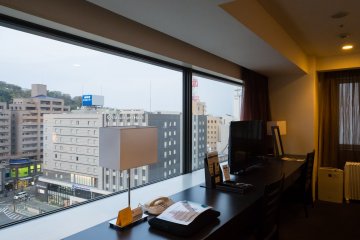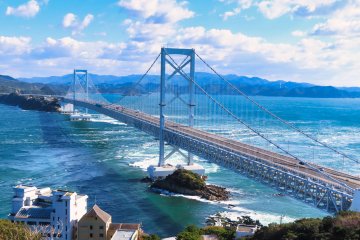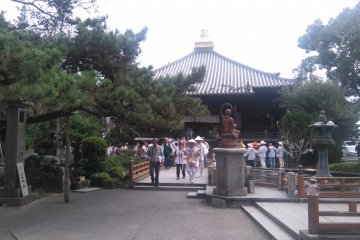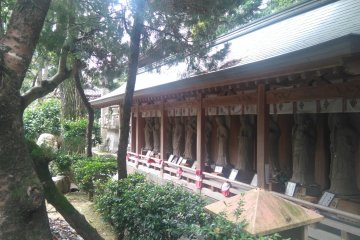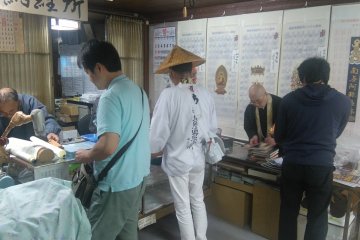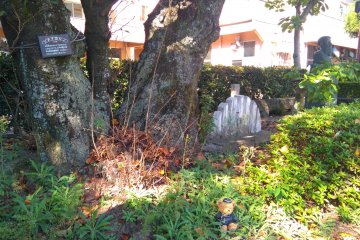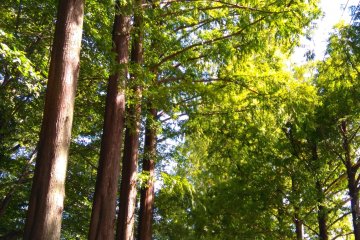Shikoku’s four regions (Shikoku means four provinces) represent the four stages of the Shikoku Pilgrimage. Tokushima, the first stage, is Awakening, Kochi, the second stage, is the place for Ascetic Training, and Ehime, the third, of Enlightenment. Kagawa, the fourth stage, is, of course, after all that hard work, Nirvana. Tokushima is the first stage because whether myth, legend, or historical fact, this was where Japan’s most revered Buddhist monk, Kobo Daishi, reputedly started the pilgrimage. Ascetic monks and pilgrims followed, forging trails now 1,202 years old. When I put on the pilgrim jacket at Ryonjenji, Temple One, I felt privileged to be a wee part of history.
There must be as many reasons for walking the Shikoku Henro as there are pilgrims, thousands every year, by tour bus, bicycle, walking, public transport. It is common to visit temples in chronological order in a clockwise direction. Brownie points are however given for going in the opposite direction, supposedly effective for those wanting to expunge grief and guilt, maybe because this makes things a bit more troublesome. Temple directions are for advancing forward to the next temple in sequential order.
What one awakens to, or works on awakening, is up to you, since the Henro welcomes one and all. I bought my hakui (white robe) at the same time as an intimidating, top to toe denim-clad Japanese giant cowboy (and I am not small) complete with boots, spurs, and gun (I didn’t ask whether it was real) in holster.
Tokushima houses Temple One - Ryozenji - to Twenty Three - Yakuoji. Ryozenji is where one gets decked out in pilgrim wear. There are Buddhist rosaries for the wrists and round the neck, amulets, holy shawls, stamp books, holy name cards, brocade cushioned walking sticks with bells. When I went, Ryozenji was a-flutter with flocks of pilgrims leaping on and off buses, the sound of fervent sutras floating as though from the clouds of incense, a long queue to get the temple stamps, priests busy flourishing their calligraphy skills on scrolls, stamp books, pieces of holy paper. Apparently Ryozenji gets even more crowded before university exams because its faithful obtain a high rate of academic success.
Ryozenji, like all the other temples, is strongly associated with Kobo Daishi. He gave Ryozenji its name, Vulture Peak Temple, after he had a vision of Buddha at Vulture Peak in India . I found the temple picturesque, with koi pond and all, although this might be too mundane a description for this holiest of holy start to the pilgrimage. At the back of the temple, I discovered evocative sculptures of people in pain and torment being comforted. As I moved on to the other temples, it seemed they got older. But then, Ryozenji was reworked in 1964. Like many other temples in Japan, it was set aflame on numerous occasions by a horrid warlord arsonist, who had many Shikoku temples suffer the same burning fate in the 16th century, so I guess it was not Rozenji's first incarnation.
Awakening for me has also meant awakening to Tokushima itself. In a few days, I experienced the warmth and kindness of people going out of their way to help. Many of its tourist attractions are within walking distance. You could do them in a day or two, if you are not into dawdling and examining old trees and boulders like I am. They have a cute shopping street, Poppo Street. There is the Mt Bizan Ropeway, the famous Awa Odori Dance, the Tokushima Castle ruins, parks and tree lined walks, all quiet and peaceful. The Awa Odori however has everyone hopping, or so I’ve read. I can’t wait.
Hopefully helpful
1.To get to Ryozenji, take the Kajiyahara bus from Platform One at Tokushima Station right up to Ryozenji.
2.Visit the Tokushima Prefectural International Exchange Association (TOPIA) for genuine friendly help, and to read English newspapers. Deft volunteers dug deep into the internet to unearth bus routes and stops the bus company didn’t have. Clement Plaza, 6th floor, at Tokushima Station, 10-6 pm daily.
3. Food awakening – taiyaki (Japanese red bean hot cakes) by the side of Sogo at the Station. A Mom and Pop place, not stingy with the filling.





